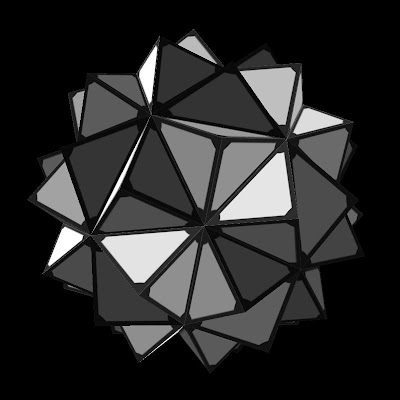The final weaving moves that are needed to close up a woven surface do not arise in most basket making for the simple reason that most baskets are not closed surfaces. Nonetheless, an ability to patch up a hole is indispensable in any fabric technique used to make topological spheres and all higher genus surfaces.
At the local level, PUCK weaving is simply tabby weave: weavers cross one another at 90 degree angles, over-one-and-under-one. Each crossing is a square of double-thickness fabric. In order for both ends of a PUCK weaver to lie buried inside the weaving, the weaver must measure an even number of squares in length. Since the zig-zagging, diagonal folds follow alternate diagonals of successive squares, a weaving unit that is an even number of squares in length will have mirror symmetry (an odd length would yield 180-degree rotational symmetry.) For example, the diagonal folds of a 4-square PUCK weaver trace out a mirror-symmetrical "W" or "M" depending on how you look at it.
For simplicity, we'll standardize the assumption that we are weaving a points-out basket from its outside. That orientation makes the diagonal folds appear as "valley folds" to use origami terminology. Note that if the four valley folds in 4-square PUCK weaver look like an "M" to you, a 180 degree rotation in the plane will make them look like "W". Again for simplicity, we'll standardize on the "W" point of view.
When 4-square PUCK weavers are shingled together (inevitably with a 2-square phase shift) to compose a longer, multi-ply weaver—depending how they are shingled—we will see shingle edges at either the leading or trailing stroke of the "W". (Recall that we are always viewing weavers from the points-out side.) Expecting that only complexity canl be gained by permitting different composite weavers to be shingled in different ways, we further standardize on leading-stroke shingling.
Once we have formed a composite weaver by shingling multiple W's together, notice that we now have two kinds of "points-out" points: points that appear to be at the bottom in the W-orientation, call these w-points, and points that appear to be at the bottom in the M-orientation, call these m-points. The two kinds of points alternate along the length of a composite weaver—and they are physically different. At a w-point we find the middle of a unit-weaver coinciding with two cut ends. At an m-point we find we find the overlap of outboard portions of two unit-weavers, and no cut ends.
In terms of individual unit weavers, each 4-square unit weaver has one w-point and two m-points.
These two physically different types of points complicate the situation in closing the last stitches of a woven surface. We may ultimately find ourselves finishing at any of four kinds of point. Ignoring the possible chiral variations, we may find ourselves finishing at a point that is mmm, mmw, mww, or www.
I am guessing that the mmm closing is easiest. In a korgome basket based on a chess-colorable triangulation, the composite weavers can be phased in a coherent way that makes every alternate point www or mmm, giving a 50/50 chance that any given point is mmm. But chess-colorable triangulations are shape limiting. In the general, non-chess-colorable case, only one eighth of the points will be mmm. However, if we know which point we will be finishing at, we can teleologically orient the three composite weavers that will cross at the finishing point to make that point mmm.




















































